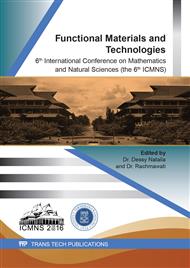p.99
p.107
p.113
p.120
p.126
p.133
p.141
p.147
p.153
The Synthesis of Polyethersulfone (PES) and its Derivatives as Polymer Light Emitting Diode (PLED) Material
Abstract:
Nowadays some types of polymer are being developed as Polymer Light Emitting Diode (PLED) materials because they have some advantages compared to small molecule organic light emitting diode (SM-OLED). Polymers which have numerous conjugated double bonds can be used as PLED materials, such as the polyethersulfone (PES) and its derivatives. Therefore, further research on the synthesis of PES and its derivatives is needed to explore their potential as PLED materials. In this research, the synthesis of polyethersulfone has been performed utilizing Microwave Assisted Organic Synthesis (MAOS) method and subsequently the synthesized PES was being transformed into the nitrated PES (PES-NO2) and the aminated PES (PES-NH2) utilizing the conventional method (reflux). Polymer structure is elucidated through FT-IR and 1H-NMR spectrum. Polymer application as PLED material is characterized by fluorescence emission spectrum. The maximum wavelengths in the fluorecence emission spectra of polymer in NMP were 444 nm for PES, 356 nm and 444 nm for PES-NO2, also 440 nm for PES-NH2.Based on the various analyses of data, the synthesis of PES, PES-NO2, and PES-NH2 has been successfully performed and all of polymers have the potent to be used as PLED materials because of its ability to emit light (blue) in the visible area.
Info:
Periodical:
Pages:
126-132
Citation:
Online since:
July 2019
Authors:
Price:
Сopyright:
© 2019 Trans Tech Publications Ltd. All Rights Reserved
Share:
Citation:


